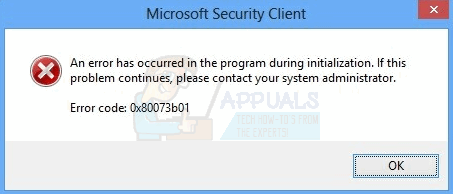How to Fix Windows Defender or Security Essentials Error 0x80073b01
Error code 0x80073b01 indicates that there is an interference between Windows Defender and another security program that you have on your computer, or there are corrupted system files that prevent it from working properly.
You might get this message when you’re trying to turn on Windows Defender on your device, and it fails. You will only get this error message, along with a few other symptoms such as not being able to find Windows Defender in the Control Panel, and you not being able to start it up. You might still get the messages that Windows Defender is up and running, and is protecting your computer, you might even be able to get updates for it, but you won’t be able to start it up. You can even try to recover it by using another antivirus software or a recovery program, but it is more than likely that you will fail.

There are a few things that you can do to solve your problem with Windows Defender, and by all means try all of them, because they tend to work in different situations, so one of them will definitely work for you.
Method 1: Uninstall any third-party security software
The first, and obvious thing to do is to uninstall any third-party security software. It is well known that third-party software such as Norton or McAfee interferes with the built-in security features of Windows, so it is highly likely that this is the problem.
- Press the Windows key on your keyboard and type in Change or remove a program.
- From the list of software currently installed, find your third-party security software.
- Click on it, and press Uninstall near the top of the window. Follow the instructions until the software is removed.
- Check the website of the manufacturer of your antivirus software. Look for a removal tool. This should help you because oftentimes, when you uninstall the software, it leaves behind files and registry entries that might still mess things up. For example, McAfee’s removal tool can be downloaded here, and Norton’s removal tool here. If you have another software, find the appropriate removal tool on the website.
- Restart your device. Windows Defender should be working just fine now. If, however, it doesn’t move on to the next method.
Method 2: Use the Registry Editor
The Registry Editor is a powerful tool, and it can often fix issues such as this one. The thing is that you should know which keys to edit, as messing up the wrong key can be fatal for your computer. Just follow the instructions in the steps below, carefully.
- Press the Windows and R keys simultaneously. In the Run window that opens, type in Regedit and press enter to open the Registry Editor.
- Use the left side navigation pane to go to

- Restart your computer, and you should be able to run Windows Defender without any issues.
Method 3: Run the System File Checker tool
The System File Checker tool is a very powerful tool that comes with Windows, and is meant to scan, find and repair corrupt system files. If the root of your Windows Defender problem is a corrupt system file, this method will fix it.
- Press the Windows key and type in Right-click the result and choose Run as administrator.
- Type in the following command, and press Enter to execute it: sfc /scannow
- Once the command is 100% complete, your problem should be fixed. If it isn’t, go to the last method and see if that helps.
Method 4: Check for updates
One more possible cause for the problem is not having all the latest updates installed. Solving this is very easy and requires no technical knowledge whatsoever, as long as you follow the steps below.
- Press the Windows key and type in Windows Update, then open the result.
- Click Check for updates and see if there are any updates available. If there are, proceed with installing them and reboot when they’re done.
As this is a fairly common issue, one of the methods above will undoubtedly help you, so feel free to try them out and see for yourself.